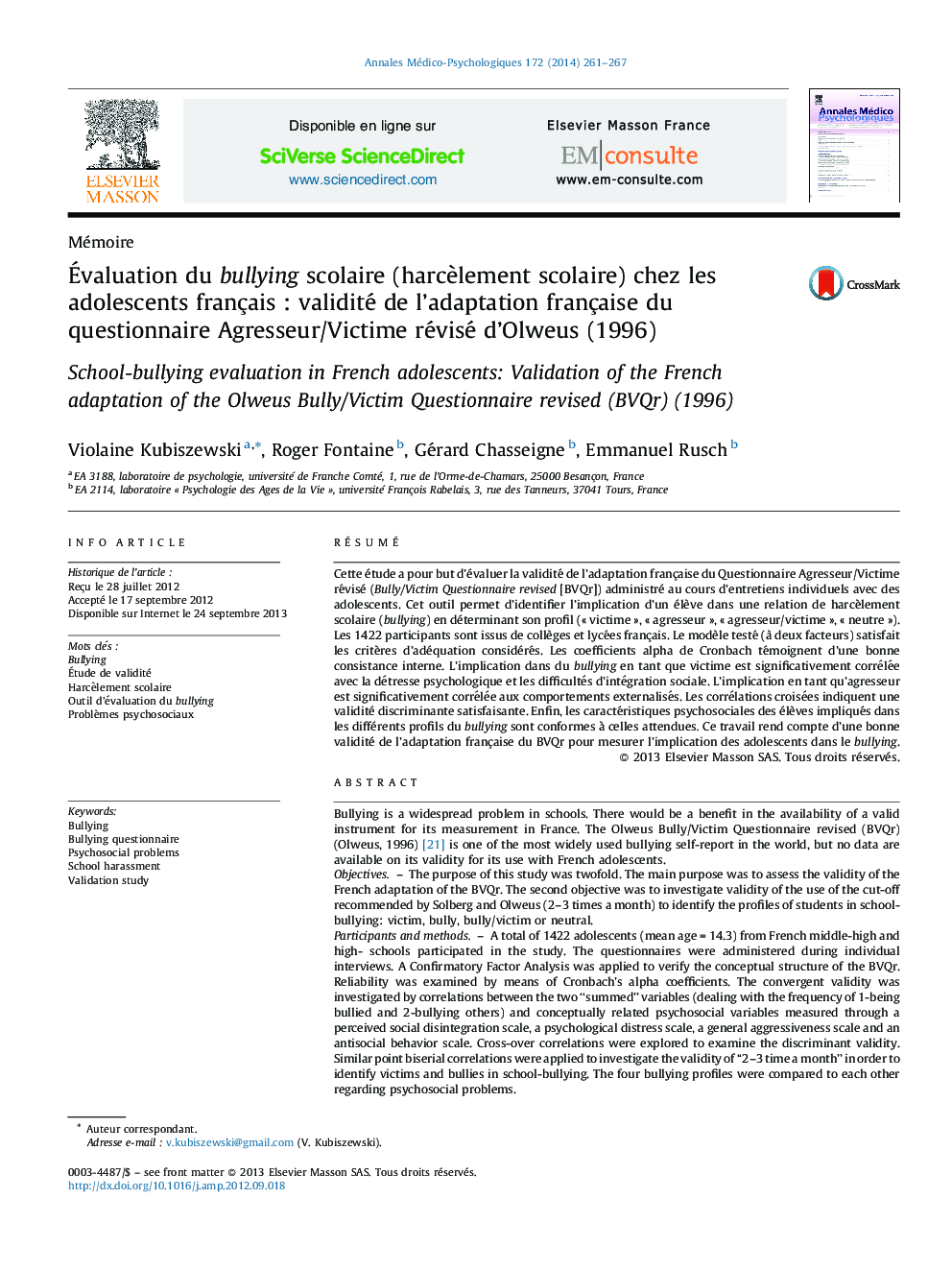| Article ID | Journal | Published Year | Pages | File Type |
|---|---|---|---|---|
| 313392 | Annales Mdico-psychologiques, revue psychiatrique | 2014 | 7 Pages |
RésuméCette étude a pour but d’évaluer la validité de l’adaptation française du Questionnaire Agresseur/Victime révisé (Bully/Victim Questionnaire revised [BVQr]) administré au cours d’entretiens individuels avec des adolescents. Cet outil permet d’identifier l’implication d’un élève dans une relation de harcèlement scolaire (bullying) en déterminant son profil (« victime », « agresseur », « agresseur/victime », « neutre »). Les 1422 participants sont issus de collèges et lycées français. Le modèle testé (à deux facteurs) satisfait les critères d’adéquation considérés. Les coefficients alpha de Cronbach témoignent d’une bonne consistance interne. L’implication dans du bullying en tant que victime est significativement corrélée avec la détresse psychologique et les difficultés d’intégration sociale. L’implication en tant qu’agresseur est significativement corrélée aux comportements externalisés. Les corrélations croisées indiquent une validité discriminante satisfaisante. Enfin, les caractéristiques psychosociales des élèves impliqués dans les différents profils du bullying sont conformes à celles attendues. Ce travail rend compte d’une bonne validité de l’adaptation française du BVQr pour mesurer l’implication des adolescents dans le bullying.
Bullying is a widespread problem in schools. There would be a benefit in the availability of a valid instrument for its measurement in France. The Olweus Bully/Victim Questionnaire revised (BVQr) (Olweus, 1996) [21] is one of the most widely used bullying self-report in the world, but no data are available on its validity for its use with French adolescents.ObjectivesThe purpose of this study was twofold. The main purpose was to assess the validity of the French adaptation of the BVQr. The second objective was to investigate validity of the use of the cut-off recommended by Solberg and Olweus (2–3 times a month) to identify the profiles of students in school-bullying: victim, bully, bully/victim or neutral.Participants and methodsA total of 1422 adolescents (mean age = 14.3) from French middle-high and high- schools participated in the study. The questionnaires were administered during individual interviews. A Confirmatory Factor Analysis was applied to verify the conceptual structure of the BVQr. Reliability was examined by means of Cronbach's alpha coefficients. The convergent validity was investigated by correlations between the two “summed” variables (dealing with the frequency of 1-being bullied and 2-bullying others) and conceptually related psychosocial variables measured through a perceived social disintegration scale, a psychological distress scale, a general aggressiveness scale and an antisocial behavior scale. Cross-over correlations were explored to examine the discriminant validity. Similar point biserial correlations were applied to investigate the validity of “2–3 time a month” in order to identify victims and bullies in school-bullying. The four bullying profiles were compared to each other regarding psychosocial problems.ResultsThe conceptual structure of the instrument was confirmed: four of the five adequacy indicators reached expected values (χ2/ddl = 7; RMSEA = 0.064; GFI = 0.95; AGFI = 0.93). The frequency of being bullied as well as being a victim of bullying were significantly correlated with psychological distress and perceived social disintegration. The frequency of bullying other and being a bully were significantly correlated with general aggressiveness and antisocial behavior. Cross-over analysis showed very low or no correlation with the psychosocial variables that were not expected to be correlated with the different bullying variables tested. Cronbach's alpha values provided evidence for good internal reliability with values ranging from 0.72 to 0.76. Finally, psychosocial problems associated with the different bullying profiles constructed with the cut-off “2–3 times a month” are similar as those expected.ConclusionThe French adaptation of the Bully/Victim Questionnaire revised has shown satisfactory psychometric properties, namely construct validity and reliability. The conceptual design of the instrument was also confirmed. Globally, our results replicate earlier findings obtained with the use of the original version of BVQr. The French adaptation of the BVQr thus appears to be valid and would help research on bullying in France.
